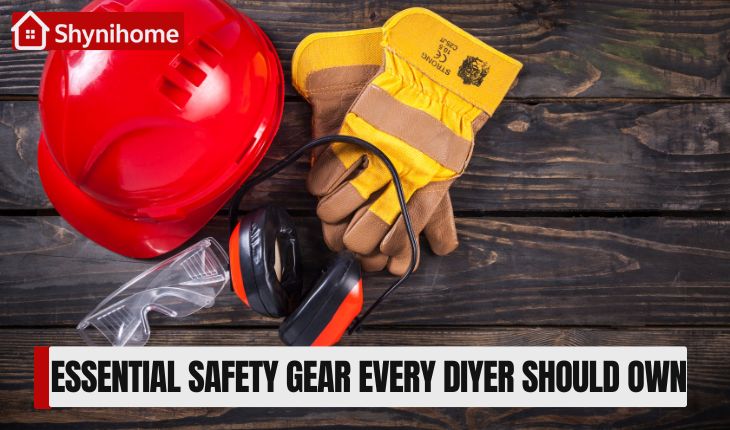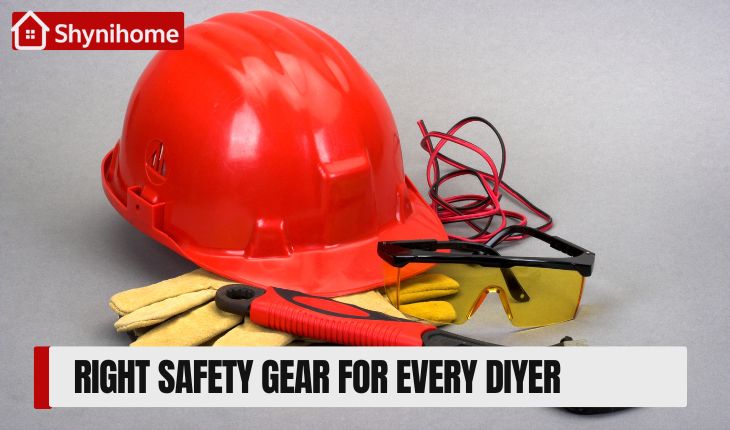
Whether you’re drilling, sanding, painting, or sawing, DIY projects can expose you to various risks. That’s why having the right safety gear is just as important as having the right tools.
In this guide, we’ll explore the must-have safety equipment every DIYer should own to stay protected and confident while working.
Table of Contents
Toggle🛠️ Right Safety Gear for Every DIYer

🧤 1. Safety Gloves
Why You Need Them:
Protect your hands from sharp tools, splinters, hot surfaces, and chemicals.
Types to Consider:
- Cut-resistant gloves for carpentry
- Rubber gloves for handling paints or chemicals
- Heat-resistant gloves for metal or welding projects
Pro Tip: Always choose gloves specific to the task for maximum protection and flexibility.
👉 Also Read: Tools for Home DIY Projects
👷 2. Safety Glasses or Goggles
Why You Need Them:
Flying debris, sawdust, or even a drop of glue can cause serious eye injuries.
Choose:
- Impact-resistant polycarbonate lenses
- Anti-fog coatings for better visibility
- Goggles with side shields for full coverage
Pro Tip: Never work with power tools without eye protection—no exceptions!
😷 3. Respirator or Dust Mask
Why You Need Them:
Many DIY tasks generate dust or fumes that are harmful to inhale—like sanding wood, mixing cement, or using strong adhesives.
Choose:
- N95 masks for dust
- Respirators with replaceable filters for fumes and chemicals
Pro Tip: Even “non-toxic” dust can affect your lungs over time. Always mask up.
🦻 4. Hearing Protection
Why You Need Them:
Prolonged exposure to loud tools like drills, sanders, or saws can lead to permanent hearing loss.
Options:
- Foam earplugs (cheap & effective)
- Noise-canceling earmuffs
- Bluetooth earmuffs for music while working
Pro Tip: Use protection anytime the noise level exceeds 85 dB.
🥾 5. Steel-Toe or Sturdy Work Boots
Why You Need Them:
Protect your feet from falling tools, nails, and heavy boards.
Features to Look For:
- Steel or composite toe
- Slip-resistant soles
- Waterproof material for outdoor work
Pro Tip: Don’t DIY in sandals or sneakers—foot injuries are more common than you think.
⛑️ 6. Hard Hat (For Overhead Work)
Why You Need It:
If you’re working on ceilings, roofing, or around suspended tools and materials, a hard hat can prevent serious head injuries.
Best For:
- Home renovations
- Loft installations
- Treehouse or outdoor structures
Pro Tip: Make sure the hat fits snugly without obstructing your view.
👖 7. Work Apron or Utility Vest
Why You Need It:
Keeps your tools within reach and protects your clothing from spills, dust, and damage.
Choose:
- Canvas or leather material
- Multiple pockets
- Adjustable straps
Pro Tip: A vest or apron can also help you stay more organized while working.
✅ Bonus: First Aid Kit
Why You Need It:
Accidents can still happen, even with precautions. Keep a stocked first aid kit nearby.
Include:
- Band-aids
- Antiseptic wipes
- Tweezers
- Burn cream
- Instant cold pack
🔐 Safety First = Success
The right safety gear can mean the difference between finishing your project strong or ending up in the ER. As a DIYer, make safety part of your routine—not an afterthought.
Remember: If you’re not protecting yourself, you’re not truly ready to build.
👉 Also Read: DIY Tools 101: A Beginner’s Guide to Home Improvement
📋 Summary Checklist
| Gear Type | Purpose |
|---|---|
| Gloves | Hand protection from cuts/chemicals |
| Safety Glasses | Protects eyes from debris and fumes |
| Dust Mask | Shields lungs from dust/fumes |
| Hearing Protection | Prevents long-term hearing damage |
| Work Boots | Protect feet from impact or nails |
| Hard Hat | Prevents head injuries during lifts |
| Work Apron/Vest | Organizes tools and protects clothes |
| First Aid Kit | Immediate response for minor injuries |
🛒 Where to Buy Safety Gear
- Local hardware stores (Lowe’s, Home Depot)
- Online: Amazon, Walmart, or tool-specific retailers
- Specialty safety suppliers (for heavy-duty gear)
